
The Aphnaeinae are a subfamily of butterflies in the family Lycaenidae.

Telipna is a genus of butterflies in the family Lycaenidae. The species of this genus are endemic to the Afrotropical realm.

Zeritis is a genus of butterflies in the family Lycaenidae. The species of this genus are found in the Afrotropical realm.

Chrysoritis felthami, the Feltham's opal, is a butterfly of the family Lycaenidae. It is found in South Africa. It was originally described by Roland Trimen under the name Zeritis felthami. This species was named in honour of Henry Louis Langley Feltham.
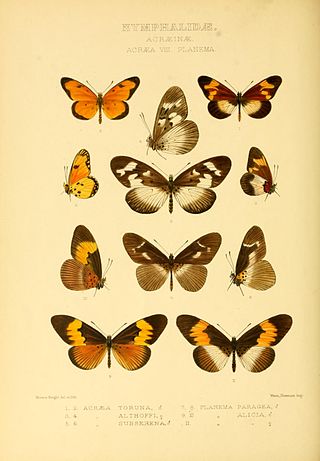
Acraea aurivillii, the large alciope acraea, is a butterfly in the family Nymphalidae. It is found in Sierra Leone, Liberia, Ivory Coast, Ghana, Nigeria, Cameroon, Gabon, the Republic of the Congo, the Central African Republic, the Democratic Republic of the Congo, Burundi, Uganda, Kenya, Tanzania, Zambia and Ethiopia. The habitat consists of forests.
Zeritis fontainei is a butterfly in the family Lycaenidae. It is found in the Democratic Republic of the Congo and Zambia.
Zeritis krystyna is a butterfly in the family Lycaenidae. It is found in central Angola.

Zeritis neriene, the checkered gem, is a butterfly in the family Lycaenidae. It is found in Senegal, The Gambia, Guinea, Burkina Faso, Sierra Leone, Ivory Coast, Ghana, Benin, Nigeria, southern Niger, Cameroon, the Central African Republic, southern Sudan, Uganda, and western Kenya. The habitat consists of savanna, where it is found on sandy soils and open stony ground with short grass.

Zeritis pulcherrima is a butterfly in the family Lycaenidae. It is found in Sudan and the Central African Republic.
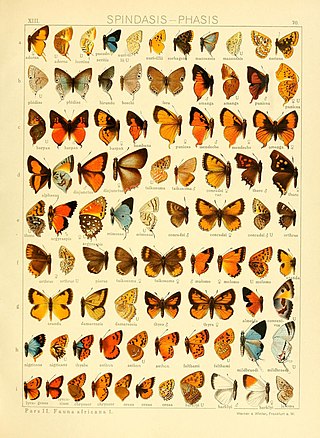
Zeritis sorhagenii, the scarce gem, is a butterfly in the family Lycaenidae. It is found in Angola, the Democratic Republic of the Congo, Zambia, Zimbabwe and Botswana. The habitat consists of understorey grass in open Brachystegia woodland.

Oboronia punctatus, the common ginger white, is a butterfly in the family Lycaenidae. It is found in Guinea, Liberia, Ivory Coast, Ghana, Togo, Nigeria, Cameroon, the Republic of the Congo, Angola, the Central African Republic, the Democratic Republic of the Congo, western Uganda and north-western Tanzania. The habitat consists of forests.

Hypolycaena lebona, the fairy hairstreak, is a butterfly in the family Lycaenidae. It is found in Sierra Leone, Liberia, Ivory Coast, Ghana, Togo, Nigeria, Cameroon, Gabon, the Republic of the Congo, the Central African Republic, the Democratic Republic of the Congo, Uganda and Tanzania. The habitat consists of forests.
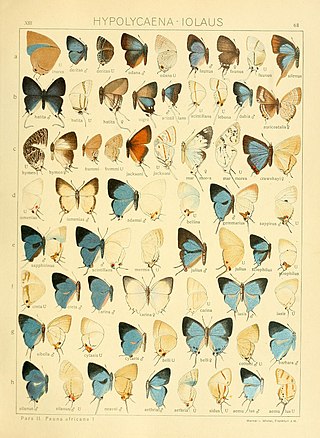
Hypolycaena nigra, the black fairy hairstreak, is a butterfly in the family Lycaenidae. It was described by George Bethune-Baker in 1914. It is found in Sierra Leone, Liberia, Ivory Coast, Ghana, Nigeria, Cameroon, Gabon, the Republic of the Congo, the Central African Republic, the Democratic Republic of the Congo, Uganda and north-western Tanzania. The habitat consists of forests.

Iolaus aurivillii, Aurivillius' sapphire, is a butterfly in the family Lycaenidae. It is found in southern Nigeria, Cameroon, Gabon, the Republic of the Congo, the Democratic Republic of the Congo, Uganda, western Kenya and Zambia. The habitat consists of forests.

Anthene lachares, the silky ciliate blue, is a butterfly in the family Lycaenidae. It is found in Sierra Leone, Liberia, Ivory Coast, Ghana, Nigeria, Cameroon, Gabon, the Republic of the Congo, the Central African Republic, Angola, the Democratic Republic of the Congo and Uganda. The habitat consists of primary forests and dense secondary forests.

Anthene larydas, the spotted hairtail or common ciliate blue, is a butterfly in the family Lycaenidae. It is found in Senegal, the Gambia, Guinea-Bissau, Guinea, Burkina Faso, Liberia, Sierra Leone, Ivory Coast, Ghana, Nigeria, Cameroon, the Republic of the Congo, the Central African Republic, the Democratic Republic of the Congo, Uganda and western Kenya. The habitat consists of forests and Guinea savanna.
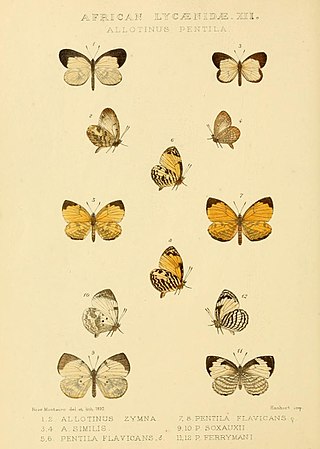
Megalopalpus zymna, the common harvester, is a butterfly in the family Lycaenidae. It is found in Liberia, Côte d'Ivoire, Ghana, Togo, Nigeria, Cameroon, Equatorial Guinea, Gabon, the Republic of the Congo, the Central African Republic, Angola, the Democratic Republic of the Congo, southern Sudan, Uganda, north-western Tanzania and Zambia. The habitat is forest and dense agricultural land.
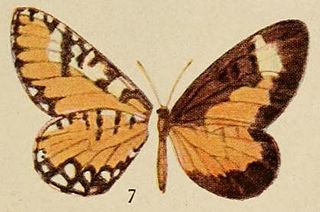
Telipna aurivillii is a butterfly in the family Lycaenidae. It is found in the Democratic Republic of the Congo and Uganda.

Mimacraea fulvaria is a butterfly in the family Lycaenidae. It is found in the Republic of the Congo, the Democratic Republic of the Congo, Uganda and Tanzania. The habitat consists of dense forests.















